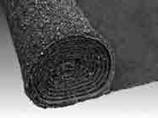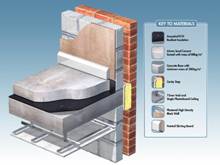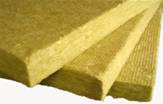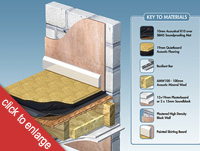ACOUSTICEL R10 and QUIETBOARD Installation Instructions
Download this as a PDF file here
PLEASE NOTE.
THESE INSTRUCTIONS MUST BE FOLLOWED OTHERWISE INCORRECT INSTALLATION COULD OCCUR WHICH MAY HAVE A DETRIMENTAL EFFECT ON THE PERFORMANCE!
Applications
Suitable for new build and conversion of separating floors contained in buildings of two storeys or more. Please note, as the structures of floors and their supporting walls varies significantly with each individual building, it may be necessary to install additional insulating measures in some cases. In the case of a newly sound insulated separating floor failing a test, contact our technical department for advice.
A resilient recycled rubber insulation providing effective sound loss when installed beneath the floor surface. Its unique formulation compensates for minor irregularities in existing floor constructions and complies with the Building Regulations for conversion and new build of both suspended timber and concrete floors. 10mm thick R10 can be laid onto existing or new timber and concrete floors with the final floor surface directly on top.
Fixing Instructions
Preparation for Conversions
On timber suspended floors, the joist should be in good condition with no interconnecting noggins. Noggins will reduce the acoustic effectiveness of the floors and if present,should be removed prior to installation of 100mm of Acoustic Mineral Wool AMW100. On timber suspended floors, the joist should be in good condition with no interconnecting noggins. Noggins will reduce the acoustic effectiveness of the floors and if present, should be removed prior to installation of 100mm of Acoustic Mineral Wool AMW100. Ensure there are no holes or gaps in the floor to be treated. |
|
|
Small gaps should be filled with our Acoustic Sealant or for more severe problems, overlay with our Sound Barrier Mat SBM5 which should be securely glued and fixed before commencing treatment. |
The floor surface should be flat and level so concrete floors may need treating with a levelling compound or screed. A better sound test will be achieved if the walls are wet plaster finished before installation of the floating floor. If a dot and dab dry lining system of plasterboard wallboards is to be used, this should be installed after installation of the floating floor and ceiling. The ceiling should also be fitted with airtight seals where the plasterboard meets the walls. All edges can be sealed with a flexible sealant.
If there is to be any stud partitions built, these should be constructed before any floating floors and ceilings are installed. NOT AFTERWARDS! and the stud wall should be constructed with a double top plate fixed to the underside of the joists and isolated with a 10mm resilient layer of M10AD. A double sole plate will also be required. After installation of the stud wall, the R10 and QuietBoard floating floor and Resilient Bar mounted ceiling can be installed as follows.
Installing Floating Floor
R10 is supplied in rolls which are unrolled and laid on the floor wall to wall withthe edges butt  jointed.
jointed.
If a wood based floating floor is to be used, it is not necessary to lap the insulation up the walls. Trimming can be done with the aid of a sharp craft knife and offcuts can be re-used.
If the floating layer is 22mm t&g chipboard or 19mm t&g QuietBoard cement impregnated chipboard, this should be laid with the joints glued using a normal PVA adhesive. |
Cutting of the boards can be achieved with either tungsten or diamond tipped blades or a metal cutting blade if using a jigsaw. Usual dust prevention measures must be taken when handling and cutting any product that creates dust. In all cases, the floating layer should be fitted to within 5-6mm (1/4") of the surrounding walls. This gap can be sealed with our Acoustic Sealant when fitting of the floor is complete. No mechanical fixings must be used which would penetrate the insulation.
NOTE: If a reinforced sand/cement screed is to go on top of the R10, the insulation must be laid FELT SIDE  UPPERMOST with the joints overlapped by 50mm and lapped up the walls to contain the screed. The mesh should then be laid prior to installation of the screed which must be a minimum thickness of 65mm.
UPPERMOST with the joints overlapped by 50mm and lapped up the walls to contain the screed. The mesh should then be laid prior to installation of the screed which must be a minimum thickness of 65mm.
The insulation can be trimmed down to floor level once the screed has cured. With both timber suspended and concrete floors, dot and dab wallboards should only be installed after the floating floor has been laid and as with the skirting boards, the wallboards should not come into contact with the floor. A gap of approx. 5mm between the bottom of the plasterboards and the floor surface should be allowed.
When applying the skirting boards, allow a 2-3mm gap between the skirting and the top of the flooring. This gap should only be filled with Acoustic Sealant if the edges of the floor have not.
Dividing Walls or Partitions
Load bearing and studwork partitions should be constructed from the base floor before installation of floating floors and ceilings. Under no circumstances should R10 be used as a load-bearing component. 10mm thick Acousticel M10AD can be used as a resilient insulation between studwork and substrate if required which can be easily cut with a jigsaw.
Ceilings
Whenever possible, these should comprise 1 x layer of 12.5mm wallboard plus 1 x layer of 19mm plasterboard plank. Alternatively, 2 x layers of 15mm Soundblock plasterboard can be used.
|
These should be screwed to our Resilient Bars which have been previously screwed to the underside of the joists. Inset lighting will also reduce the acoustic effectiveness of the ceiling and so only surface mounted lights should be fitted. |
If inset lights are required, these can be fitted into a separate suspended ceiling installed after insulation of the separating ceiling with Resilient Bars has been completed.
For more information on installing our products, please contact our technical department.







